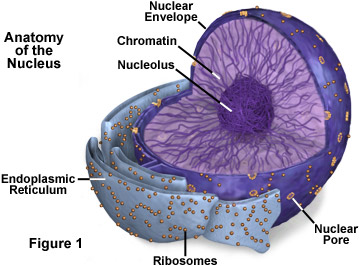INTRODUCTION:

Nucleus as a cell organelle was first described by Robert Brown as early as 1831. Later the material of the nucleus stained by the basic dyes (Acetocarmine was given the name chromatin by Flemming.
"Nucleus is double membrane bound dense protoplasmic body, which controls all cellular metabolism and encloses the genetic information of cell".
Nucleus is consider as controller or director of cell. Importance of nucleus in control of heredity. growth and metabolism was Largest alga). experimentally proved by Hammerling Experiment was an Acetabularia a single cell
Generally eukaryotic cell contain at least one nucleus but nucleus is absents in mature phloem sieve tube elements and mature RBCs of mammals.
Dikaryotic (Paramoecium) and multikaryotic cells are also known.
STRUCTURE OF INTERPHASE NUCLEUS :
i) Interphase nucleus : Nucleus of cell when it is not dividing
ii) Nuclear membrane or karyotheca.
iii) Nuclear matrix/Nucleoplasm/Karyolymph/Sarcoplasm.
iv) Chromatin net
v) Nucleolus/little nucleus/Ribosome factory
i) Nuclear membrane :
- Electron microscope has revealed that the nuclear envelope, which consists of two preme ne n a space between (10 to 50 um) called the perinuclear space. These actors a s a batter between the material present.inside the nucleus and that the cytoplasm.
- The intermembrane usually remains continuous with the endoplasmic reticulum and also beschloss
- At a number of places the nuclear envelope is interrupted by minute pores, which ats lormed bu the Son of two membranes These nuclear pores otet passages through which movement END and protein molecules takes place in both directions between the nucleus and the cytoplasm.
- The nucleus he nuclear pore, is guarded by a octagonal discold structure of nucleoplasmin protein.
- The inner side of Inner nuclear membrane is lined by nuclear lamina This structure is formed by filaments of lamin protein.
ii) Nucleoplasm or Karyolymph :
Nucleoplasm or Nuclear sap is a ground substance of nucleus, which is a complex number of chemicals in nucleotides, nucleosides. ATP proteins & enzymes Chromatin net and nucleolus are components of nucleoplasm.
A) Chromatin net :- (Term Given by Fleming)
- Interphase ucles has a loose and indistinct network of nucleoprotein fibers called chromatin, which Embedded in nucleoplasm. Chromatin net is mainly formed of DNA and histone per complexes.
- Chromatin fibres contain genetic information and condensed to form chromosomes during cell division.
- During different stages of cell division cells how structured chromosomes in place of nucleus.
- Chemically chromatin consists of DNA, RNA Histone protein (asic proteins, rich in arginine and in and non histone proteins:
Chromatin net has two type of chromatins:
A) Euchromatin : This is lightly stained and diffused part of chromatin. Which is transcriptionally or genetically more active.
B) Heterochromatin : This is dark stained thick and condensed part genetically less active or inactive chromatin.
i) Constitutive heterochrómatin:- Occurs in all cells in all stages eg. centromeric region.
ii) Facultative heterochromatin :- Occurs in some cells in some stages ag barr body in females,
B) Nucleolus :-
The nucleoli are spherical and membraneless structure so that the content of nucleous is continuous with the rest of the nucleoplasm.
It is a site for active ribosomal RNA (r-RNA) synthesis.
Nucleolus usually attached to chromatin (or chromosomes) at specific site called Nucleolar organiser region/NOR.
Nucleolus is called Ribosome factory of cell.
- Larger and more numerous nucleoli are present in cells actively carrying out protein synthesis.






0 comments:
Post a Comment
If you have any doubts. Please let me know.